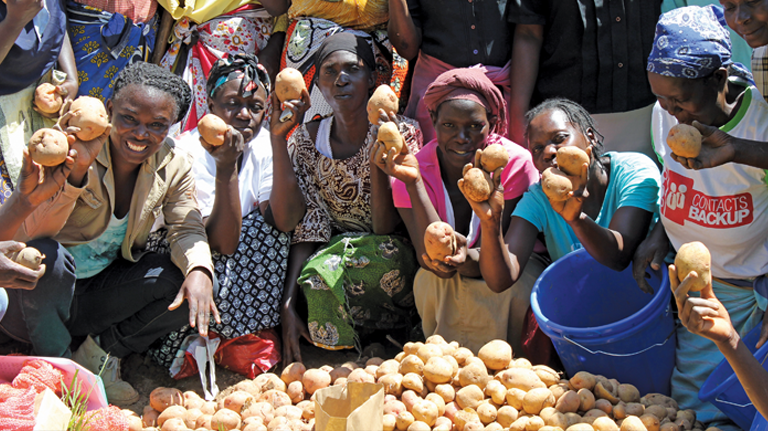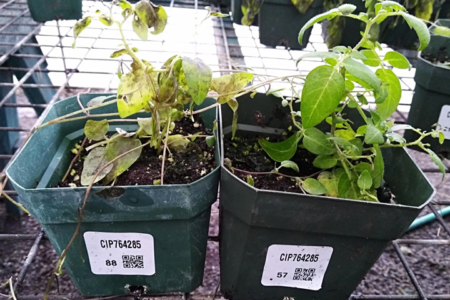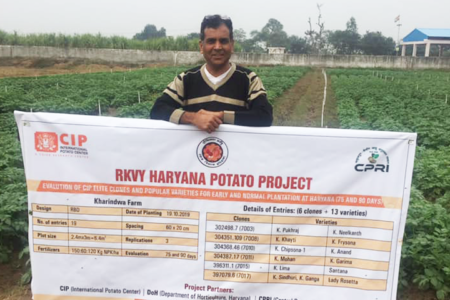
Starting with six already released potato varieties, this project will identify the two or three most commercially viable and promote a seed system for these varieties to address the food needs of the burgeoning population.
Background
Intensification of food production is urgently needed for the burgeoning populations of the East and Central African highlands. Potato is a smalholder cash crop in these areas and has great potential to raise livelihoods while reducing poverty and improving food and nutrition security. With a yield potential of 51,603 kilocalories per hectare per day in a short growing season (90–120 days), potato’s productivity in terms of energy is the highest of all major arable crops, almost double that of rice and wheat, and also has high protein production (1.4 kg/ha per day).
In general, potato is well suited to places where land is limited and labor abundant—a characteristic of many of many poor and developing countries. Potato’s short and highly flexible vegetative cycle fits well with the double-cropping season in the East African highlands. In rainfed systems, potato is one of the first crops that can be harvested after the onset of the rainy season, thus enabling an important ‘hunger-break’ before grains can be harvested.
However, climate change is threatening to potato production systems in East Africa through increasing exposure to extreme weather conditions, primarily floods and droughts. In many of the drier potato-growing regions, water and heat stress are leading to declining yields. Where there is no possibility of irrigation, yields will decrease even further. In the tropics and subtropics, yields are expected to decline by 20–30%. Even in traditional potato growing areas between 1,500 and 3,500 meters, increasing temperatures and periodic droughts have been observed over the last decade. The rapidly increasing population in the highlands is reducing available land, forcing farmers to migrate to the lower, warmer and drier areas.
To adapt potato to these challenges, breeders and researchers from the International Potato Center (CIP) are prioritizing their breeding and selection strategies on resilience to identify the most likely varieties to resist climate-induced stressors. CIP has selected a set of robust potato germplasm with traits such as heat tolerance, earliness-to-ripen, virus and late blight resistance, and good water-use efficiency, among others.
These germplasm were selected by support from the Syngenta Foundation for Sustainable Agriculture (SFSA) project ‘Evaluation and selection of heat and drought tolerance of CIP potato germplasm’ (2014–2016). In nontraditional potato growing areas, at altitudes below 1,800 meters, and with average growing-season precipitation of 200-400 mm, most of the 37 candidate varieties (CIP clones) yielded more than 10% above mean yields of registered varieties, and six yielded more than 25% above—an extremely high-performance advantage. After national performance trials in Kenya, two of the six varieties were registered in 2016 and four in 2017.
Objectives
The project will meet its goal of disseminating the heartiest and consumer-demanded potato varieties by fulfilling the following objectives:
- To identify the two or three most commercially viable varieties of the six released;
- To create awareness of and demand for these varieties through market release;
- To establish a seed system in which registered seed multipliers have access to newly released varieties to increase certified seed production, and decentralized multipliers receive early generation seed to multiply locally; and
- To identify and facilitate the release of additional varieties with commercial potential

Approach
With a view to identifying the two or three best performing varieties, CIP will thoroughly evaluate the six varieties already released in terms of seed multiplication efficiency to determine per unit costs and farmer demand. This work will include determining multiplication rates at each stage of production and consequently the total cost of production of certified seed. CIP will simultaneously collect basic agronomic data and look at resistance to diseases such as potato cyst nematode, tolerance to heat, and late blight and bacterial wilt. The most popular local varieties will be used as controls.
To determine demand, 250 tubers of 3-5 varieties will be distributed to at least 1,000 farmers, who will provide performance feedback via an SMS questionnaire. New varieties will also be promoted at agricultural shows and distributed to other potato projects and government initiatives.
To further create awareness and demand for the new varieties, farmer groups will receive 50 kg of the varieties for distribution among their members, along with instructions on bulking, information about the varieties, and contact information of the seed producers. The project will ensure that clean seed is available at field days and in non-traditional potato-growing regions. New varieties will be included in the National Potato Council of Kenya potato variety catalogue. The project will produce promotional material, including agronomic and organoleptic information on the varieties and will be distributed with the seed bags and at agricultural fairs.
CIP will work with three registered seed merchants with which it has already established a working relationship to multiply seed from ‘starter’ materials (e.g., in-vitro plantlets, mini-tubers, rooted apical cuttings). Starter materials will also be shared with the national potato program, the parastatal Agricultural Development Cooperation, and new potato seed multipliers.
An additional 12 CIP clones are being evaluated within the mid-altitude national performance trials. These varieties will be assessed critically to identify one or two varieties with the highest commercial potential at each site.
Expected outcomes
CIP has previously trained over 1,000 decentralized seed multipliers. This network will disseminate new varieties to over 10,000 farm households. If these farmers sell or share 10% of their harvest for others to use as seed, more than 15,000 farmers will be reached.
| Key outcomes | Target |
| Climate-smart, grower- and consumer-demanded potato varieties disseminated | 25,000 farmer households |
| Certiö ed seed of newly released varieties | 500 tons/year (in 2020) |
Contact
Kalpana Sharma
CIP, Kenya
kalpana.sharma@cgiar.org
Thanks to our donors



